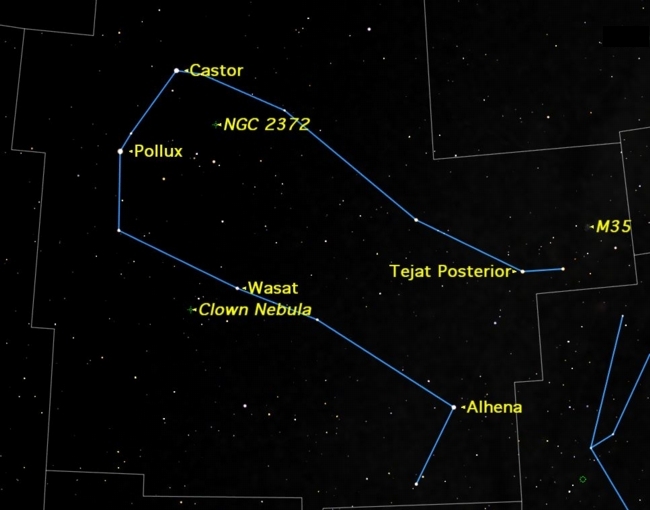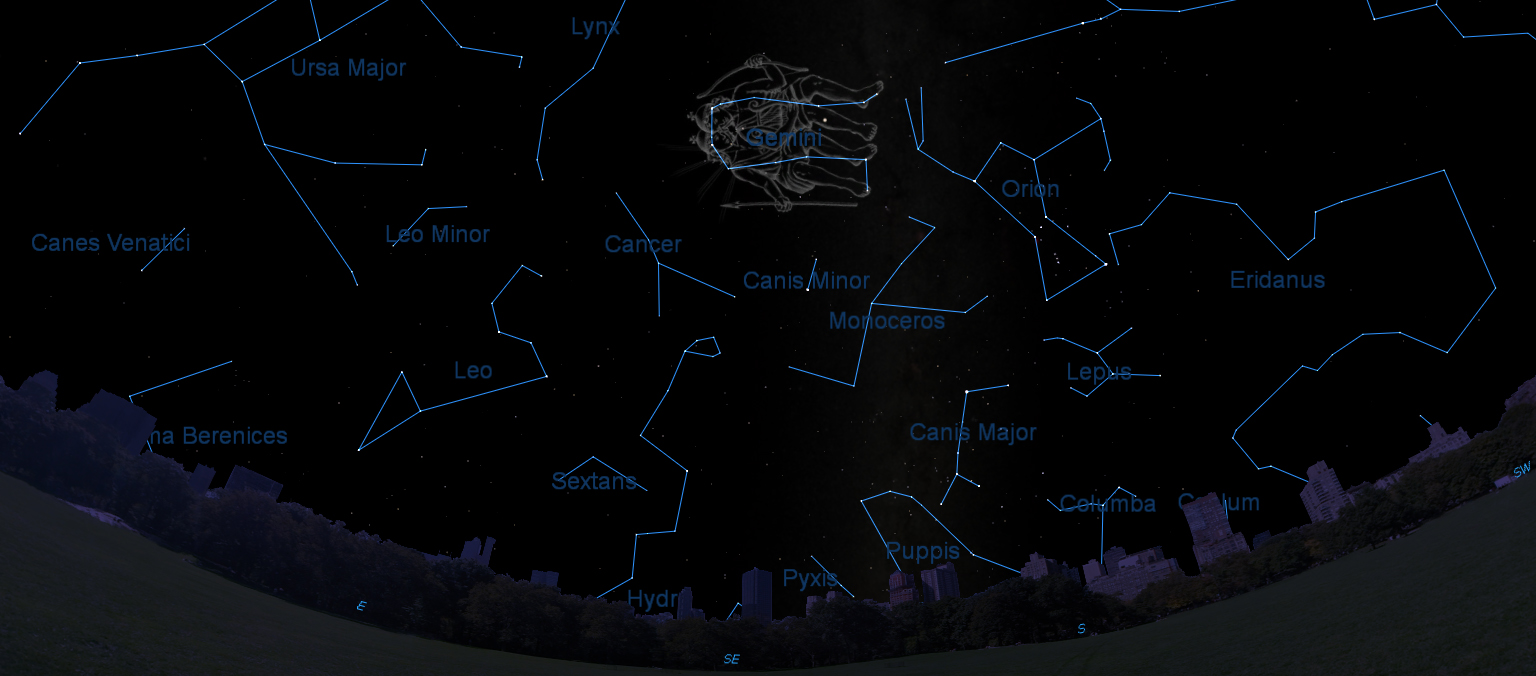Winter Skywatching: Spot Jupiter and the 'Heavenly Twins'

Probably the most eye-catching object these cold winter evenings lies well up in the southeast sky soon after dark — Jupiter, the largest planet in our solar system.
It takes nearly 12 years for Jupiter to make one full circuit of the sky, and since there are 12 zodiacal constellations, this means that Jupiter spends about a year within the boundaries of a different member of the zodiac. And 2014 finds Jupiter residing in Gemini, the Heavenly Twins, a constellation that rewards a great deal of exploration.
The heads of the Twins are the bright stars Pollux (yellowish) and Castor (white; a bit dimmer than Pollux). The stars that compose the duo's arms and bodies are fainter than those in their heads and feet. A second-magnitude star known as Alhena marks one of Pollux' feet. [Amazing Night Sky Photos by Stargazers for February]
In his two popular star guides, "Find the Constellations" and "The Stars: A New Way to See Them," the late H.A. Rey was able to trace these stars into a fairly convincing pattern of two matchstick figures holding hands, which pretty much resembles what this constellation is supposed to be. In places where light pollution hides many of the fainter stars, only Pollux, Castor and Alhena may be visible, forming a long isosceles triangle with the vertex angle pointing straight at Orion, the Mighty Hunter.
A tragic battle over love
It is perhaps appropriate that this year Jupiter is positioned almost smack in the middle of the stars of Gemini, since Jupiter was involved in one of the many ancient folk tales that revolved around the Twins.
It seems that Pollux was immortal while brother Castor was not. They were warriors, famous navigators and adventurers, and during their travels they once fell in love with two beautiful sisters. Unfortunately for Pollux and Castor, the sisters were already engaged to be married, so the Gemini Twins called out their rivals to do battle for the hands of the beautiful maidens. But only Pollux survived the intense battle.
Breaking space news, the latest updates on rocket launches, skywatching events and more!
Pollux was so overcome with grief that he attempted to commit suicide so that he could join his brother in the abode of Hades, the god of the underworld. But Pollux was unsuccessful because he was immortal. He then approached Jupiter with a request: Either bring Castor back to life, or let him die with his brother.
Jupiter was so touched by Pollux' devotion to his brother that he rewarded him by making the twins an everlasting symbol of brotherly love, and placed both in the sky. Perhaps because he was immortal, the star Pollux appears a bit brighter than the star Castor; the pair appear as a convenient landmark in the night sky separated by just 4 degrees, or just less than half the width of your fist held at arm's length.
As Peter Lum wrote in his book "The Stars in our Heaven," they are as "close together in eternity as they had been in mortal life."
Castor is actually a system of six stars, forming one of the most remarkable examples of a multiple star in the heavens.
In 2006, Pollux was confirmed to have an exoplanet orbiting it.The alien world is circling Pollux with a period of about 590 days. [The Strangest Alien Planets]
Zeta Geminorum, on the outstretched left 'leg' of the twin Pollux,is a pulsating Cepheid star, its brightness changing from magnitude +3.7 to +4.2 and back again in 10.1 days.
The ruddy star Propus (from the Greek, meaning "forward foot") of the western twin, Castor, is a triple star systemwhose greatest claim to fame is that it was the star nearest to Uranus when William Herschel ran across it in 1781.
Just above and to the right of Propus lies number 35 in Charles Messier's famous catalogue. Located just off the trailing foot of Castor, M35 can just be seen with the unaided eye on dark transparent nights.
In low-power binoculars, it may look like a dim, fairly large unresolved interstellar cloud, but look again. Even through light-polluted suburban skies, 7-power binoculars reveal at least a half dozen of the cluster's brightest stars against the whitish glow of about 200 fainter ones.
M35 has been described as a "splendid specimen" whose stars appear in curving rows, reminding one of the bursting of a skyrocket. Walter Scott Houston (1912-1993), who wrote the Deep-Sky Wonders column in Sky & Telescope magazine for nearly half a century, called M35 "one of the greatest objects in the heavens; a superb object that appears as big as the moon and fills the eyepiece with a glitter of bright stars from center to edge."
Comet masquerader
I myself am not embarrassed to relate this personal episode: In September 1985, while camping in the Adirondacks of northern New York, I was scanning the Orion-Gemini region near M35. I stumbled across a faint circular cloud of light that for a few minutes had me thinking that I just found a new comet.
In reality, however, it turned out to be a faint open star cluster known as NGC 2158. If you get a chance to train a telescope on M35 and come across this small, faint patch of nebulosity a short distance away, at least you won't be making the "comet mistake" that so many others have made. Houston himself fell into this trap, later calling NGC 2158 his "lasting monument to my early, somewhat careless, years of observing."
Someday "Comet Rao" may yet be discovered, but I certainly won't be mistaking it anytime soon with NGC 2158!
Editor's note: If you have an amazing picture of a constellation or any other night sky view that you'd like to share for a possible story or image gallery, send photos, comments and your name and location to managing editor Tariq Malik at spacephotos@space.com.
Joe Rao serves as an instructor and guest lecturer at New York's Hayden Planetarium. He writes about astronomy for Natural History magazine, the Farmer's Almanac and other publications, and he is also an on-camera meteorologist for News 12 Westchester, N.Y. Follow us @Spacedotcom, Facebook or Google+. Originally published on Space.com.

Joe Rao is Space.com's skywatching columnist, as well as a veteran meteorologist and eclipse chaser who also serves as an instructor and guest lecturer at New York's Hayden Planetarium. He writes about astronomy for Natural History magazine, Sky & Telescope and other publications. Joe is an 8-time Emmy-nominated meteorologist who served the Putnam Valley region of New York for over 21 years. You can find him on Twitter and YouTube tracking lunar and solar eclipses, meteor showers and more. To find out Joe's latest project, visit him on Twitter.


